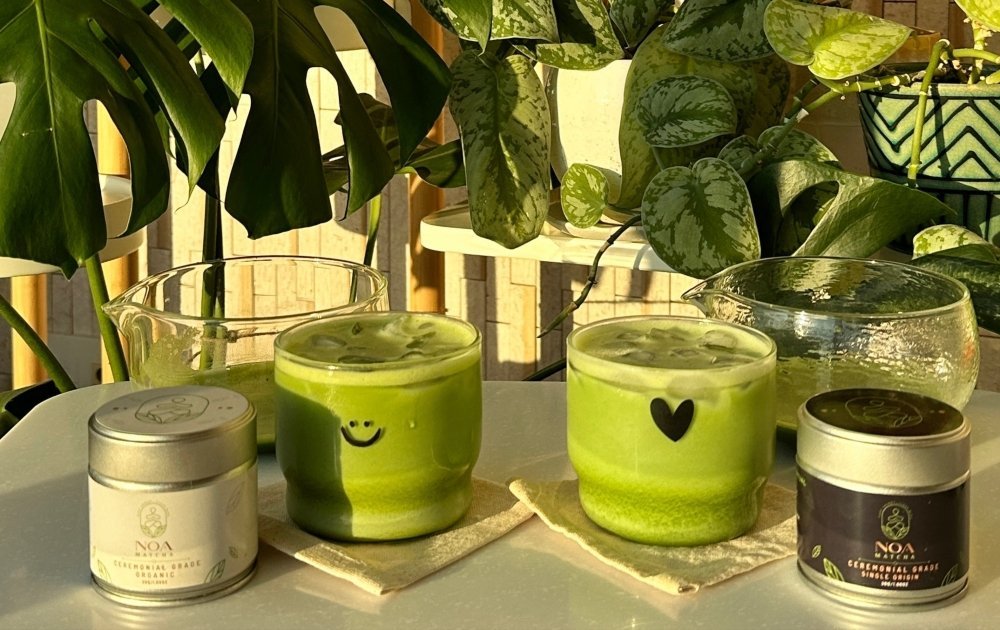
Matcha 101: Everything You Need to Know About Matcha in Australia
Learn everything you need to know about matcha in this comprehensive guide for Australians. Discover the different grades, health benefits, how to prepare it, and where to find the best organic matcha
Matcha's popularity is booming in Australia, from Sydney's cafes to Melbourne's kitchens. This vibrant green powder is more than a trend; it's a delicious, centuries-old beverage with potential health benefits. But understanding the different types of matcha can be tricky. This guide provides Australians with a complete overview of matcha. At Noa Matcha, we're passionate about premium, organic matcha and transparent sourcing. Ready to learn more? Let's get started, and discover how to choose and enjoy the perfect cup!
What is Matcha?
Matcha is a unique type of green tea, originally from Japan. Unlike regular green tea where you steep and discard the leaves, matcha involves consuming the entire tea leaf, finely ground into a powder. This delivers a more concentrated dose of nutrients and antioxidants.
The process starts weeks before harvest when the tea plants (Camellia sinensis) are shaded. This boosts chlorophyll (giving matcha its vibrant green color) and L-theanine (an amino acid linked to calm focus). The best leaves, called Tencha, are hand-picked, steamed, dried, and ground using stone mills. The result is a smooth powder with a distinctive, slightly sweet, umami flavor. Because you consume the whole leaf, you get a more potent dose of green tea's beneficial compounds.
Check out our page for How matcha is made or the Matcha History
The Different Grades of Matcha
Understanding the different grades is crucial for choosing the right matcha.
Ceremonial Grade Matcha: Ceremonial grade is the highest quality. Made from the youngest leaves, usually from the first harvest, it has a vibrant green color, a fine texture, and a delicate, naturally sweet flavor. Premium Ceremonial grade is traditionally used in Japanese tea ceremonies, whisked with hot water. Enjoy it on its own to appreciate its nuanced flavor. Organic types of this grade is also available in Noamatcha shop
Culinary Grade Matcha: Culinary grade is designed for use in recipes like lattes, smoothies, and baked goods. It's often made from later harvests and has a slightly stronger flavor that stands up to other ingredients. Within culinary grade, there are sub-categories:
- Premium: A good balance of flavor, color, and price, ideal for everyday lattes and smoothies.
- Classic: A versatile option for a wide range of recipes.
- Ingredient/Kitchen: More astringent, best for baking and cooking where it will be mixed with strong flavors.
How to Choose the Right Grade:
In short: Use ceremonial grade if you plan to drink it straight, whisked only with hot water. Use culinary grade for lattes, smoothies, and other recipes.
The Health Benefits of Matcha
Matcha is popular for its taste and potential health benefits, thanks to its high concentration of antioxidants and other compounds. Please consult with a healthcare professional for personalized advice.
Antioxidants and Catechins:
Matcha is exceptionally rich in antioxidants, especially catechins. These help protect your cells from damage caused by free radicals, which contribute to aging and health issues. Epigallocatechin gallate (EGCG), a particularly potent catechin, is abundant in matcha.
L-Theanine and Focus:
Matcha contains L-theanine, an amino acid promoting relaxation and mental clarity without drowsiness. L-theanine works with caffeine (naturally present in matcha) to provide sustained, calm energy and improved focus, often called "calm alertness." This is why many prefer matcha over coffee for a balanced energy lift.
Other Potential Benefits:
Matcha has also been linked to other potential benefits, like a possible metabolism boost. However, remember that matcha is part of a healthy lifestyle, not a miracle cure.
How to Prepare Matcha
Proper preparation greatly affects matcha's flavor.
Traditional Preparation (Usucha - Thin Tea):
The traditional Japanese method, Usucha, involves whisking matcha with hot (not boiling) water:
- Sift: Sift 1-2 teaspoons (2-4 grams) of ceremonial grade matcha into a bowl (chawan) to remove clumps.
- Add Water: Add 60-80ml of hot water (70-80°C or 158-176°F).
- Whisk: Use a bamboo whisk (chasen) and whisk vigorously in a "W" or zigzag motion until a frothy layer with tiny bubbles forms.
- Enjoy: Sip directly from the bowl.
Matcha Latte Preparation:
For a creamy matcha latte:
- Matcha Paste: Whisk 1-2 teaspoons of culinary grade matcha with a small amount of hot water (about 30ml) to create a smooth paste.
- Heat Milk: Heat your choice of milk (dairy or non-dairy, like almond, soy, or oat milk) until hot, but not boiling.
- Combine: Add the matcha paste to a mug, then pour the hot milk over it.
- Sweeten (Optional): Add sweetener (honey, maple syrup, or sugar) to taste.
- (Optional): Use a milk frother for a creamier texture.
Other ways to use Culinary Matcha: Add culinary matcha to smoothies, yogurt, oatmeal, or baked goods like cakes and cookies. Experiment to find your favorites!
For more details, check our seperete blog post on How to produce Matcha
Where to Buy High-Quality Matcha in Australia
Look for organic matcha to ensure it's free from pesticides and herbicides. Noa Matcha offers premium, certified organic matcha sourced directly from Japan. We're committed to the highest quality, transparency, and ethical sourcing, so you can feel good about every cup. Visit our Australia online shop to explore our ceremonial and culinary grade matcha and experience the Noa Matcha difference!
Conclusion
Matcha offers a unique blend of flavor, tradition, and potential health benefits. We hope this guide has given you a solid understanding of this remarkable green powder. We encourage you to try different grades, experiment with preparation, and find your perfect cup. Visit the Noa Matcha shop today and start your matcha journey!
Disclaimer: The information provided in this section is for general knowledge and informational purposes only, and does not constitute medical advice. It is essential to consult with a healthcare professional for any health concerns or before making any decisions related to your health or treatment.


0 comments